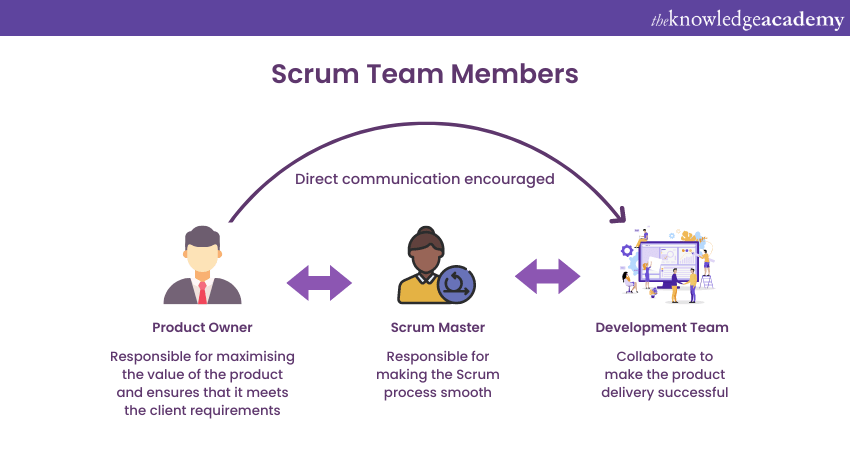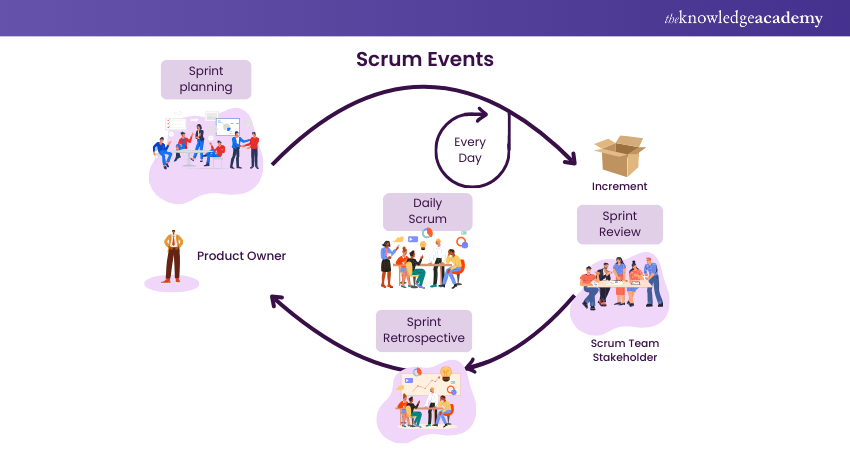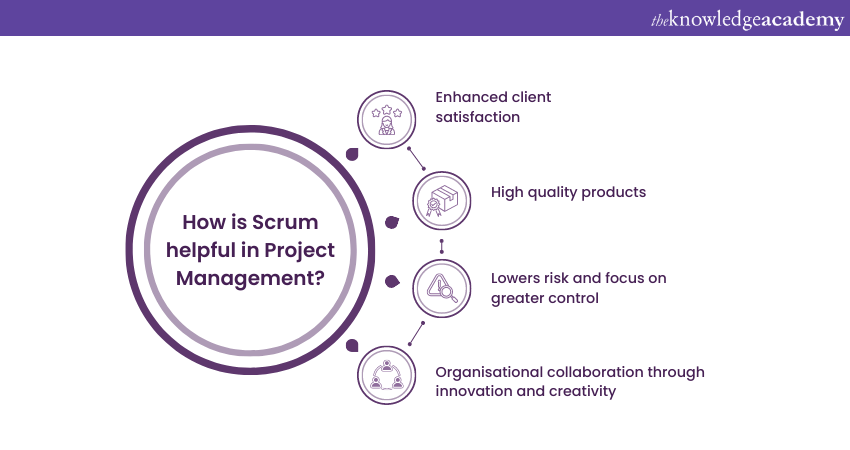We may not have the course you’re looking for. If you enquire or give us a call on 01344203999 and speak to our training experts, we may still be able to help with your training requirements.
Training Outcomes Within Your Budget!
We ensure quality, budget-alignment, and timely delivery by our expert instructors.

Project Management teams are often looking for ways to simplify each task they perform. However, most of them face challenges when it comes to adopting a proper methodology. This is where Scrum Methodology can become their helping hand.
Scrum is the most well-known and simple Agile framework. It assists individuals, groups, and organisations to produce value by developing flexible solutions to challenging issues. This Methodology helps manage projects with cross-functional teams to deliver a functional component from conception to completion. Scrum Methodology finds its application in many projects other than just Software Development.
Scrum Methodology is a tried-and-tested technique. It is frequently used to simplify the work of the development teams and help them maintain the applications. This iterative cycle can be repeated as long as enough work items are finished by working in sprints of shorter duration. According to the State of Agile Report, four out of five organisations use Agile and Scrum teams to manage their work and ensure it is completed efficiently and effectively. It is therefore evident that implementing this methodology can be helpful in facilitating amazing projects.
But how can this Agile method do wonders? How can one implement it in their organisational structure? Read this blog to discover What Scrum Methodology is and how it helps in Project Management to create better results faster.
Table of Contents
1) What is Scrum Methodology?
2) Scrum Methodology and its process
3) Members representing a Scrum Team
4) Events in Scrum Methodology
5) How is Scrum Methodology helpful in Project Management?
6) How do Scrum Methodology and Agile Methodology vary from one another?
8) Conclusion
What is Scrum Methodology?
Scrum Methodology helps manages projects with cross-functional teams, each equipped to deliver a functional component from conception to completion. It is an Agile framework that is quick, flexible, and effective and is designed to deliver value to the customer throughout the project's development. In addition, it also focuses on high progress visibility.
Its primary goal is to meet the customer's needs by fostering a culture of open communication, shared accountability, and constant improvement. The Scrum Methodology serves as a roadmap for transparency, inspection, and adaptation for team to create the quality products.
It is helpful for several business types, for organisations that prioritise results over the tracking of process progress. This is because being innovative and efficient drives better results rather than a fixed and detailed process, which is what Scrum focuses on.
Scrum Methodology can aid businesses that create customisable products. Its flexibility to change makes it essential for meeting customer demands. The projects that require teams to finish a backlog are best suited for the Scrum Methodology. It simplifies complex projects by breaking down each process into manageable pieces.

Principles of Scrum
Scrum is a way of working together in a team to get things done effectively. It has some important principles and values that guide its process. Here are few Scrum Principles that you should be aware of:
a) Transparency: In a team, it's crucial that everyone is aware of the difficulties others might be dealing with. Constant face-to-face conversations among team members with different skills and the person in charge of the project help prevent misunderstandings. It also helps to keep information flow smooth.
b) Reflection: In Scrum, teams often stop their work to check how everyone are doing the work. Project Managers listen to insights to make improved decisions in the future. This helps projects go smoothly while staying within budget and finishing on time.
c) Adaptation: Team members can change the order of their tasks as per the customer’s need. In that way they will have an idea about which tasks to finish first and which to work on in future.
Scrum values
There are mainly four values that project teams in Scrum must follow. These values are discussed below:
a) Commitment: Scrum Team members must be focused on finishing tasks on time. They must also work to make things better by trying to find better ways to do things.
b) Courage: The courage to ask tough questions must be a trait of Scrum team members. They must talk about everything freely without any hesitation. This helps to find the best answers together.
c) Focus: In Scrum, team members must have a list of jobs to do called the "Product backlog." They must pick certain tasks to work on and finish them within a set time.
d) Openness: Scrum team members must be open to fresh ideas and opportunities. This helps them learn and grow individually as well as together.
e) Respect: The Scrum team members should respect one another, the Project Managers, and the Scrum process. The respect they show to each other develops the spirit of mutual collaboration and cooperation within the team.
Scrum Methodology and its process
Scrum is an Agile Project Management framework which is designed to ensure an iterative and incremental development of products and services. Its process revolves around small, cross-functional teams working in short iterations called Scrum Sprints. These Sprints typically last two-four weeks. Here's how the process works:
The Scrum process begins with a Sprint planning meeting where the team selects items from the product backlog to work on during the Sprint.
Daily stand-up meetings keep the team aligned, while the sprint review and retrospective meetings allow for reflection and adaptation at the end of each Sprint.
This iterative approach allows teams to quickly respond to change and deliver high-quality products incrementally.
At the end of each Sprint, a review meeting is held to demonstrate completed work to stakeholders and gather feedback.
The Sprint concludes with a retrospective where the team reflects on what went well and what could be improved.
This continuous feedback loop allows for rapid adaptation to changing requirements, ensuring the development of high-quality products that meet customer needs.
Members representing a Scrum team

A Scrum team is a compact, adaptable group of individuals committed to meeting agreed-upon product milestones. Usually consisting of a small group of people, it finishes a significant amount of work in a sprint. A typical team has the following roles:
Scrum Product Owner
A Product Owner's responsibility is to collaborate with stakeholders to develop a goal for the product they want to develop and to convey that vision to the team and stakeholders. They prepare a thorough and regularly updated to-do list for the project to ensure the team consistently delivers value to stakeholders and the business.
They maintain the product backlog and to always look for future Sprints to ensure the backlog items are prepared for the team. The Product Manager is not usually the same as the Product Owner; they are concerned with ensuring that the Development Team adds the maximum value to the company.
Scrum Master
The Scrum Master oversees the entire development process. They ensure that the rules are enforced and applied correctly, and regular meetings with the team are organised. Knowing how to run the process for the team is the role played by the Scrum Master.
They also maintain a proper balance with the project's major stakeholders, i.e., the Product Owner. They are responsible for what needs to be created, and the team's developers are responsible for how it should be made.
Learn about using different techniques of Scrum Master and the responsibilities of this role by signing up for our Scrum Master Certification course now!
Scrum Development Team
The Scrum Development Team drives each Sprint's plan. This team consists of specialists with technical competence working together to complete their assigned targets. Using past data and information as a reference, they predict how much work they can complete during one Sprint. Keeping the length of the Sprint constant provides the Development Team with valuable feedback on their estimation and delivery processes, allowing them to improve their forecasts over time.
Team members have diverse skill sets and mutually mentor one another to ensure that no single contributor to the team becomes a bottleneck in the work delivery process. All team members work together to ensure the success of the Sprint.
In short, knowing how to run the process for the team is the role played by the Scrum Master. They also maintain a proper balance with the project's major stakeholders, i.e., the Product Owner. They are responsible for what needs to be created, and the team's developers are responsible for how it should be made.
Learn how to communicate better with a Scrum team and get insights on the different roles and responsibilities within members of a Scrum by signing up for our Scrum For Teams course now!
Events in Scrum Methodology
The Scrum Sprints completed by each team in the Scrum Methodology consist of several events, which you can easily map out on Scrum events. Such events are valuable opportunities to examine and modify the product, process, or both. The events are discussed as under:

The Sprints completed by each team in the Scrum Methodology consist of several events, which you can easily map out on Scrum Template. Such events are valuable opportunities to examine and modify the product, process, or both. The events are discussed as under:
Sprint planning
The Sprint planning includes making decision about the strategies to adopt during each task and how the Scrum team should implement them. Each Sprint meeting establishes the project's approach based on the stages and deadlines in the Product Backlog. For instance, a Sprint that lasts a month should be planned in a stipulated time duration of eight hours. However, shorter Sprints should have a smaller time duration.
In Scrum, team members set clear goals for the Sprint. By the end of the planning meeting, everyone on the Scrum team understands how they can complete each part of the project during the Sprint.
Daily Scrum meeting
A Daily Scrum is a short meeting where team members sit together and plan for the day A daily Scrum meeting should be 15 minutes long. It is a brief gathering that happens every day of the Sprint period. A plan for the next day is created after reviewing the activities and assessing the progress and trend until the Sprint ends.
Sprint review
With stakeholders, the entire Scrum team reviews the work that has been finished and the Sprint's results and decides on any necessary modifications going forward. After reviewing the Sprint's results, the stakeholder should see noticeable improvement and provide feedback, if any, on the final product. The Product Owner may adjust the list of tasks in the product backlog during the ongoing Sprint.
Sprint retrospective
The Sprint comes to an end at this point. The Sprint retrospective pinpoints the potential process enhancements and produces a plan to put them into action in the next Sprint. In addition, the team reviews Sprint's finished goals, notes both the good and the bad, and comes up with ways to enhance the efficiency and engagement of the team members in the upcoming Sprint. The team gathers to write down and talk about what went well and what didn't go well during the Sprint. This helps them gain ideas to make future Sprints better.
How is Scrum Methodology helpful in Project Management?
Let's discuss how Scrum Methodology is helpful in Project Management:

Let's discuss how Scrum Methodology is helpful in Project Management:
Enhanced client satisfaction
In Scrum Methodology, features and improvements of any product are much more driven by customers, ultimately resulting in a better product. This is because the capacity to provide real value is possible in one Sprint. The customer begins interacting with the product and giving feedback just after the first Sprint, and this process in Project Management continues throughout its lifecycle.
Better products result in happier customers as they were actively involved in its creation. This serves as another benefit of consistent customer involvement in the process that ultimately leads to increased value and client satisfaction.
High-quality products
Frequent communication with customers and stakeholders helps determine whether the product satisfies their needs. This communication happens in a Sprint Review meeting, which is conducted once every two weeks. During this meeting, if they are consulted about the changing requirements needed in the product, then there is a possibility that in the next Sprint Review meeting, the updated product will be demonstrated. As a result, it will drive the potentiality of developing high-quality products.
Lowers risk and focuses on greater control
A Scrum Methodology in Project Management enables everyone involved in the project—from the client to the stakeholder, from the developer to the Scrum Master to understand their roles and the timeline for each task. As a result, projects are better managed. In addition, team members regularly communicate and work together to reduce unknowns and unexpected crises. The experience relating to project risk will decrease because there is more focus on working together more efficiently.
Organisational collaboration through innovation and creativity
Scrum Methodology in Project Management enables integrated team members such as Product Designers, Product Developers, Testers, and others to leverage their talent and knowledge in addition to the skills they already possess. This is done by fostering creativity and innovation and combining abilities from different and various disciplines by collaborating in an atmosphere of product development. As a result, this leads to the final product integrating with the best skills of the business organisation.
How do Scrum Methodology and Agile Methodology vary from one another?
Agile is a way of thinking in Software Development. It's like a way of working together in a company where everyone tries to get better all the time and make sure they give customers what they really want. Scrum is a tool which helps team to do their work better in the Agile way. It gathers all the important ideas from Agile and provide teams with a plan to follow.
Conclusion
We hope you learned about the Scrum Methodology, its process, and strategy. In this blog, we explained the roles played by individuals in a typical Scrum project and how this methodology benefits Project Management. The goal of this methodology is to promote effective team communication and a better understanding and appreciation of the various roles that each team member plays.
Gain an in-depth understanding of the concepts present in Agile and Scrum and use them together by signing up for our Managing Agile Projects With Scrum course now!
Frequently Asked Questions

Scrum Sprints can be as long as you want. However, the standard length is between one and four weeks. Teams running Scrum Sprints can decide what makes sense for them.

The Scrum Methodology is commonly used for managing and streamlining the development process of complex projects, especially software development. It focuses on teamwork and accountability toward a well-defined goal through regular Sprints and meetings.

The Knowledge Academy takes global learning to new heights, offering over 30,000 online courses across 490+ locations in 220 countries. This expansive reach ensures accessibility and convenience for learners worldwide.
Alongside our diverse Online Course Catalogue, encompassing 17 major categories, we go the extra mile by providing a plethora of free educational Online Resources like News updates, Blogs, videos, webinars, and interview questions. Tailoring learning experiences further, professionals can maximise value with customisable Course Bundles of TKA.

The Knowledge Academy’s Knowledge Pass, a prepaid voucher, adds another layer of flexibility, allowing course bookings over a 12-month period. Join us on a journey where education knows no bounds.

The Knowledge Academy offers various Scrum Certification Training, including Scrum Master Certification Course, Scrum Product Owner Training and Scrum Developer Training. These courses cater to different skill levels, providing comprehensive insights into Agile Project Management With Scrum.
Our Project Management Blogs cover a range of topics related to Scrum, offering valuable resources, best practices, and industry insights. Whether you are a beginner or looking to advance your Project Management skills, The Knowledge Academy's diverse courses and informative blogs have you covered.
Upcoming Project Management Resources Batches & Dates
Date
 Scrum Master Certification
Scrum Master Certification
Thu 1st Aug 2024
Thu 8th Aug 2024
Thu 15th Aug 2024
Thu 29th Aug 2024
Thu 5th Sep 2024
Thu 19th Sep 2024
Thu 26th Sep 2024
Thu 3rd Oct 2024
Thu 10th Oct 2024
Thu 17th Oct 2024
Thu 24th Oct 2024
Thu 31st Oct 2024
Thu 7th Nov 2024
Thu 21st Nov 2024
Thu 5th Dec 2024
Thu 19th Dec 2024
Thu 2nd Jan 2025
Thu 9th Jan 2025
Thu 16th Jan 2025
Thu 23rd Jan 2025
Thu 30th Jan 2025
Thu 6th Feb 2025
Thu 13th Feb 2025
Thu 20th Feb 2025
Thu 27th Feb 2025
Thu 6th Mar 2025
Thu 13th Mar 2025
Thu 20th Mar 2025
Thu 27th Mar 2025
Thu 3rd Apr 2025
Thu 1st May 2025
Thu 22nd May 2025
Thu 5th Jun 2025
Thu 19th Jun 2025
Thu 3rd Jul 2025
Thu 17th Jul 2025
Thu 31st Jul 2025
Thu 14th Aug 2025
Thu 11th Sep 2025
Thu 25th Sep 2025
Thu 2nd Oct 2025
Thu 9th Oct 2025
Thu 16th Oct 2025
Thu 23rd Oct 2025
Thu 30th Oct 2025
Thu 6th Nov 2025
Thu 13th Nov 2025
Thu 20th Nov 2025
Thu 27th Nov 2025
Thu 4th Dec 2025
Thu 11th Dec 2025
Thu 18th Dec 2025







 Top Rated Course
Top Rated Course


 If you wish to make any changes to your course, please
If you wish to make any changes to your course, please


